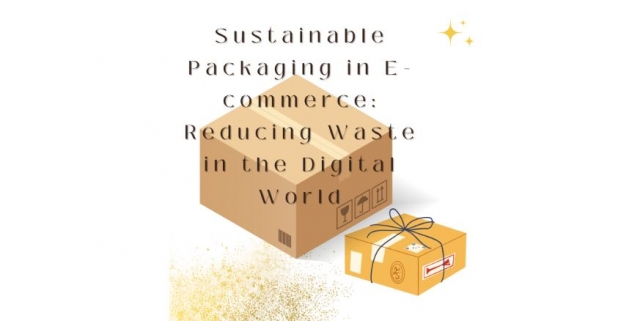In today's world, convenience and variety are available at our fingertips in all aspects of our lives. We can see this most especially in the exponential growth of e-commerce and the increase in the number of online shopping platforms. The way we shop has been completely transformed, and the majority of people no longer need to visit a physical store to make a purchase.
However, this surge in online shopping has brought a significant environmental challenge: packaging waste. As companies try their best to meet consumer demands, they sometimes have to use excessive and non-eco-friendly packaging.
In this article, we will talk about the critical issue of sustainable packaging in e-commerce, exploring its importance, current practices, innovations, and future directions.
The Environmental Impact of E-commerce Packaging
E-commerce relies heavily on packaging to protect products during shipping. Unfortunately, this often results in over-packaging, with multiple layers of cardboard, plastic, and filler materials. The environment is significantly affected by this kind of practice:
It consumes resources
Many resources are needed to produce traditional packaging materials such as plastic and non-recycled cardboard. For example, fossil fuels which are significant raw materials for making plastic contribute heavily to greenhouse emissions.
It Generates Waste
As the rates of online shopping increase, there is also a corresponding increase in packaging waste. According to the Environmental Protection Agency (EPA), packaging accounts for about 30% of the total waste generated in the United States.
It Causes Pollution
Improper disposal of packaging materials, especially plastics, leads to pollution of land and water bodies. Plastics can take hundreds of years to decompose, and this will be harmful to the environment in the long run.
The Importance of Sustainable Packaging
Sustainable packaging addresses these issues by reducing harmful environmental impact through various strategies. Here are some reasons why it is important:
Conservation of Resources
Sustainable packaging often uses materials that are renewable, recycled, or require less energy to produce, this way, natural resources can be conserved.
Reduction of Carbon Footprint
By using eco-friendly materials and optimizing packaging design, companies can reduce their carbon footprint by a great amount.
Waste Reduction
Sustainable packaging aims to minimize waste through better design, and by making sure that the packaging materials can be recycled and are biodegradable. This way, less material ends up in landfills.
Consumer Preference
More and more consumers are asking for eco-friendly products lately. This is a good thing for companies that use sustainable packaging practices, as they can improve their brand image and appeal to these customers.
Current Sustainable Packaging Practices
Many companies are already taking steps to reduce their environmental impact through innovative packaging solutions. Here are some common practices:
The Use of Biodegradable Materials
Biodegradable materials decompose on their own, naturally. They reduce the burden of waste on the environment. Examples include plant-based plastics, paper, and biodegradable films.
Recycled Content
When companies use recycled content in packaging, the need for fresh resources is no longer there or it is reduced. Cardboard and paper products are examples of products that are commonly recycled into new packaging.
Minimalist Packaging
As time goes on, more and more companies are adopting minimalist designs that use the least amount of material necessary. This not only reduces waste but also cuts shipping costs.
Reusable Packaging
Some companies are considering reusable packaging solutions. For instance, some shopping platforms now use durable containers that customers can return for cleaning and refilling.
Eco-friendly Inks and Adhesives
It is not news that traditional inks and adhesives can contain harmful chemicals. So, therefore, some companies are investing in eco-friendly alternatives that are made from natural substances and are less harmful to the environment.
Innovations in Sustainable Packaging
Innovations in sustainable packaging are paving the way for a greener e-commerce industry. Here are some cutting-edge developments:
Edible Packaging
Researchers are developing packaging made from edible materials like seaweed, which can be eaten or turned into compost, therefore leaving no waste behind.
Smart Packaging
This technology involves the use of sensors and indicators to provide real-time information about the condition of the product, reducing the need for excessive protective packaging.
Algae-based Packaging
Algae is a renewable natural resource that can be used to create biodegradable packaging materials. It is particularly promising due to its rapid growth and low environmental impact.
Mushroom Packaging
Made from mycelium, the root structure of mushrooms, this packaging is biodegradable and can be composted after use.
Nanotechnology
Advances in nanotechnology are enabling the creation of stronger, lighter, and more environmentally friendly packaging materials.
The Role of Consumers
Consumers play an important role in driving the demand for sustainable packaging. Here are some ways they can contribute:
Choose Eco-friendly Brands
When consumers show their support for brands that use sustainable packaging, they can encourage more companies to adopt similar practices.
Recycle Properly
When you as a consumer correctly recycle your packaging materials, you can contribute to reducing waste in the environment.
Advocate for Change
Consumers can use their voices to advocate for more sustainable practices, pushing companies to start looking for eco-friendly solutions.
Reduce and Reuse
Consumers should reduce their packaging waste whenever possible and find ways to reuse packaging materials.
Challenges and Barriers
Despite all the progress made, there are also some challenges and barriers that prevent the widespread adoption of sustainable packaging in e-commerce. Some of these are:
High Cost
Sustainable materials and technologies can be more expensive than traditional options, and not all companies can afford to use them. In the long run, it pays off, but not everybody thinks that far ahead.
Consumer Behavior
While there is a growing demand for sustainable products, not all consumers are vocal about wanting eco-friendly packaging, which can impact a company's decision-making.
Regulatory Hurdles
Regulations regarding packaging and waste management are different in each region, and this sometimes makes it difficult for companies to implement uniform sustainable practices.
Future Directions
Despite all these problems, the future of sustainable packaging in e-commerce looks promising. It will be driven by innovation, consumer demand, and regulatory pressures.
Some trends to watch out for shortly are:
An Increase in the Use of Renewable Materials
As technology advances, the cost and availability of renewable materials are expected to improve, making it possible for them to be used in more areas.
More Companies will Adopt Circular Economy Models
More companies are likely to adopt circular economy principles. When they do this, they design packaging that can be reused, recycled, or composted, thus minimizing waste.
Introduction of Stricter Government Regulations
Governments are expected to introduce stricter regulations regarding packaging waste and recycling. This is a way to push companies towards more sustainable practices.
Collaborative Efforts
Partnerships between companies, governments, and non-profits will also be an important part of developing and implementing effective sustainable packaging solutions.
Consumer Education
At the end of the day, consumers also have a role to play. Educating consumers about the importance of sustainable packaging and how they can contribute will also be crucial in driving change.
Conclusion
Sustainable packaging in e-commerce is not just an environmental necessity but also a business choice. As the digital world continues to expand, the need for eco-friendly packaging solutions will only grow.
By adopting sustainable practices, companies can reduce their environmental impact, meet consumer expectations, and stay ahead in an increasingly competitive market. The journey towards sustainability is just beginning, requiring innovation, collaboration, and commitment from all involved stakeholders.
Together, we can reduce waste and build a more sustainable future for e-commerce platforms.
Frequently Asked Questions
What constitutes sustainable packaging?
Sustainable packaging refers to the use of materials and design techniques that minimize environmental impact. This can include the use of recycled or biodegradable materials, reducing packaging size, and creating reusable packaging options. The goal is to reduce waste, conserve resources, and lower the carbon footprint associated with packaging.
What materials are commonly used in sustainable packaging?
Common materials include biodegradable plastics, recycled paper and cardboard, plant-based materials such as cornstarch and seaweed, and innovative options like mushroom-based packaging and algae-derived materials. These materials are selected for their reduced environmental impact compared to traditional plastics and non-recycled materials.
How does sustainable packaging benefit businesses?
Sustainable packaging can improve a company's brand image, attracting environmentally conscious consumers. It can also lead to cost savings through reduced material use and shipping costs. Additionally, as regulations around packaging waste become stricter, sustainable practices can help businesses stay compliant and avoid penalties.






